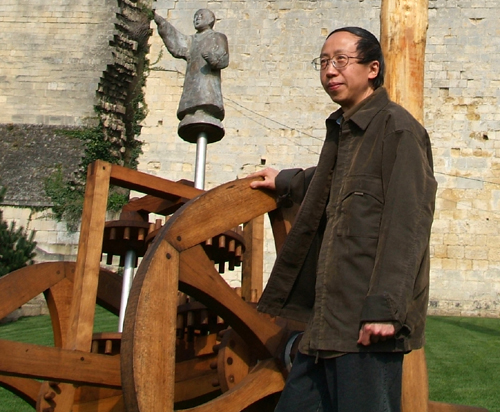
Huang Yong Ping with a replica of Chinese South-Facing-Wagon, photo china.org.cn
Huang Yong Ping
崔 永 培
Dada Theoretician, Installations,*1954 Xiamen, lives in Paris since 1989

Huang
Yong Ping with a replica of Chinese South-Facing-Wagon, photo
china.org.cn
Huang was born in Xiamen in southern
China in 1954. Along with artists such as Zhang Xiaogang and Xu Bing,
he was part of the first wave of students admitted to the newly
reopened art academies following the Cultural Revolution (1966–76).
While at the Zhejiang Academy of Fine Arts in the late 1970s and
early 1980s, Huang gained access to Western art and philosophy books
in Chinese translation, and became interested in French postmodern
theory and the work of Marcel Duchamp, John Cage and Joseph Beuys.
Huang found connections between Taoist and Zen Buddhist thought, with
its embrace of constant change, and the deconstructive,
dematerialising strategies of Dada. In 1986, he co-founded the
influential avant-garde group Xiamen
Dada, which staged several radical events that included burning
paintings at the end of an exhibition, and installing construction
materials in a gallery instead of art works.
Since 1989, Huang has
lived in Paris. As with many artists of his generation, he left China
at the time of the Tiananmen Square crackdown, which registered an
end to the increasingly open expression that had built since the end
of the Cultural Revolution. Living in France enabled Huang to
participate actively in the international art world, exhibiting
widely and raising awareness of Chinese avant-garde art, particularly
in Europe. It also encouraged him to shift his practice to address
the interaction of different cultures in an increasingly globalised
world. In Huang’s works since 1989, Chinese symbols and mythology
are often intertwined with those of the West, overlaid with
references to the locality where the work is shown.
Queensland Art
Gallery QAGOMA
Huang Yong Ping refuses to be drawn into political arguments in China. Despite his expatriate status, through the power of his intellectual and artistic insight alone he has become one of them most influential theoretians in contemporaty Chinese art.
Xiamen Dada
1986-1988
Xiamen Dada is an art
group founded in 1986 by Huang Yongping, Cha Lixiong, Liu Yiling, Lin
Chun and Jiao Yaoming. Antagonistic to pre-conceived notions of art,
they found similarities between Chan Buddhism and Dada in the
recognition of the impossibility of truth. The group was primarily
identified with the ideas of Huang Yongping, set out in ‘Xiamen
Dada—a Kind of Postmodernism?’ (Xiamen Dada—yizhong
houxiandai?) in 1986. Works in the Xiamen Dada exhibition of the same
year were characterized by the use of modern styles and found
objects. The artists publicly burned some of the works at the end of
the exhibition as an act of self-liberation, and were consequently
barred from holding further public events.
On the relationship
between original Dada and Xiamen Dada see walkerart.org
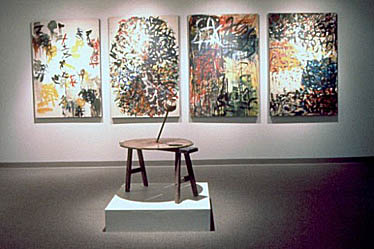
Four
Paintings Created According to Random Instructions from a Chinese
Wheel of Chance(1985)
Excerpt from Huang Yong Pin,“Completely Empty Signifiers: ‘Dada’ and ‘Chan Buddhism’” (1988)
“Dada in Western modern art
history and Chan Buddhism in the history of ancient Chinese thought
can serve as examples of completely empty signifiers. Here the phrase
“completely empty signifiers” doesn’t contain any ontological
or metaphysical intention. “Empty” is used as the category
diametrically opposed to “substantial,” without implying any
metaphysical statement of “empty is substantial.” We’ll stick
to the linguistic level, without going into an in-depth
discussion.
Chan Buddhism as a term in the history of ancient
Chinese thought can be traced back to the Buddhist classics. In the
Wudeng Huiyuan, or the Collection of Five Lamps, Volume 1: Buddha, it
is noted: “Buddha sat on the peak of Vulture Mountain with an
assembly of monks, he then picked up a flower and showed it to them.
Everybody in the assembly remained silent, not knowing what he meant
by this action. Only Mahakasyapa smiled. The Buddha then said: ‘I
have the eye of the true law, the secret essence of Nirvana, the
formless form and the ineffable Dharma which is not dependent on
speech or words; a special transmission beyond all the other
teachings. All this, I pass to Mahakasyapa.”
From
walkerart.org
This “manifesto” - it is much longer, of course – describes the raison d'etre behind all of Huang's work.
The House of
Oracles
1993-2005
The House of Oracles is, by any measure, a bizarre collection of artifacts, which can only be understood through Huang's commentaries. A touring exhibition, which HYP added to over the years, ended at the Walker Art Museum in Washington,DC in 2005, who published an exemplary catalog with copious explanantrions by the artist (HYP). I will present an equally 'random' selection of objects with abbreviated comments by HYP.
“The House of Oracles brings
together all kinds of objects relating to the I
Ching (Book of Changes) and other systems of divination that I
used between 1989 and 1992. Even today, I still consult the I Ching
on every project I do. This allows me to obtain unexpected
possibilities and find alternative solutions to my hesitation or
indecisiveness as to what to do or how to carry out a project.
Since
1987 my method of working has gradually changed from “choice guided
by chance” to the use of oracles. These two methods or systems both
consist in minimizing the individual power of the artist, that is,
the myth that art is the creative act of a single individual. The
system of divination is older than that of “choice guided by
chance”; it is also a strategy that enables me to shake off Western
influences and at the same time to access sources more readily (i.e.,
Chinese traditions).
As a system of divination, the I Ching can
be used to interpret oracles. Although the result of divination is
equivocal, suggestive, or metaphorical, it does have a real influence
on my way of thinking. Using “oracles” implies man’s conscious
acceptance of their influence on him. This relationship between man
and the art of divination is immeasurable.
walkerart.com
|
|
'Theater
of the World', 1993, a box filled with live insects devouring
each othter. The cover spells the Chinese character 'gu' 蠱,
gu is composed of two separate radicals—the first radical (虫)
denoting an insect, repeated three times and superimposed upon
the second, a dish or plate (⽫).
The character also denotes the eighteenth hexagram and chapter in
the I CHING, which represents decay. The hexagram comprises the
first trigram (Gen, “keeping still, mountain”; one solid line
above two broken lines) over the second (Xun, “the gentle,
wind”; two solid lines above one broken line). |
|
|
|
|
|
|
|
|
|
|
|
|
Arche
Noah
2009
Chapelle des Petits-Augustins, École
Nationale Supérieure des Beaux-Arts, Paris
Having successfully stuffed elephants and tigers Huang set out to fill an entire Ark of Noah with animals He got the idea in 2008 during a visit to Paris’s famed taxidermy shop Deyrolle, just after the notorious fire that destroyed most of its stock. Seeing the charred ostriches, lions and elk, Huang recalls, he immediately thought of the Old Testament fable: “It was as if the animals had survived the flood but not the fire afterwards.” He bought a few of the animals from Deyrolle and went on to acquire or construct dozens more: tigers, turtles, birds, and giraffes to populate a paperboat with them.
.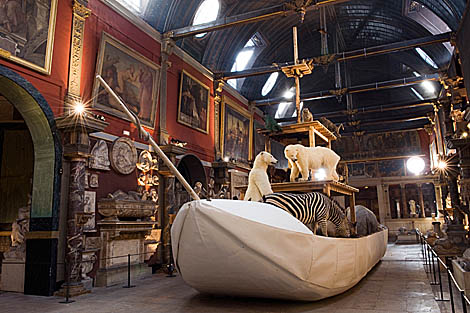
Wood,
paper and taxidermied animals,15 m x 8 m
|
|
|
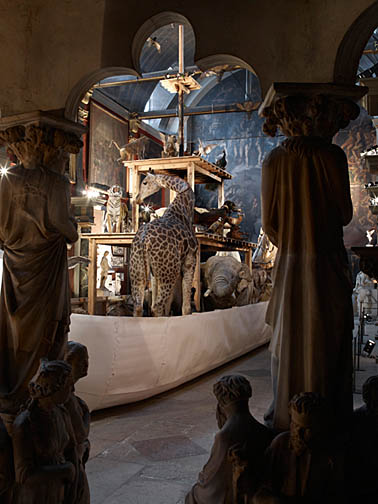
The installation of the Ark in the Chapelle des Petits-Augustins of the École Nationale Supérieure des Beaux-Arts in Paris was surrounded by 17th century sculptures and paintings culminating in a darkened copy of Michelangelo’s Last Judgment over the altar, mysteriously hinting at the pessimistic thoughts of Huang Yong Ping.
“In the Bible, Noah’s ark is
protected by God, it is safe, and even the lions are well
behaved. In my boat the animals are wounded, have been burnt, and
they are fighting each other. I don’t want to know, exactly, what
burned the animals,” says Huang. “In any case, the fire comes
from within, not from the outside. Violence and savagery,”he adds,
”are innate characteristics of living beings and lie at the root of
our society’s problems: The current crisis is a reflection of human
qualities. It’s a result of the mad, depraved side of human
beings.” -
Inexplicably, Noah, his wife and childre are not
found on his boat.
'Wu Zei'
, 乌贼,
an Octopus posing as Cuttlefish
2010
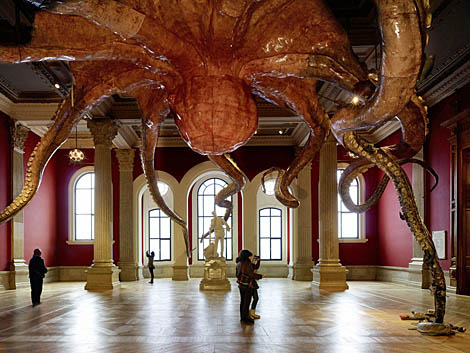
A huge Octopus/Cuttlefish, “Wu Zei”, 乌贼, at the Oceanographic Museum of Monaco completes Huang's menagery of fantastic animals
“Wu Zei”, a gigantic hybrid
animal—an octopus and a cuttlefish—is inspired by the sea and
refers to the maritime disasters caused by man. While its head is
suspended around the Medusa chandelier, designed by the German
biologist, philosopher and free thinker Ernst Haeckel, its tentacles
invade the gallery space. One of the tentacles circles around the
column, another stretches out towards the first room of the
exhibition, and others reach out towards the sea and the statue of
Prince Albert I.
The hybrid animal’s head is red like that of
an octopus; its tentacles are black like those of a cuttlefish. One
of the tentacles looks set to suck in, like a vacuum cleaner, the
different objects and blackened animals lying on the floor.
By calling his installation “Wu
Zei”, Huang Yong Ping creates an ambiguity in the meaning of his
work. The title “Wu Zei” (乌贼)
is the Chinese name for a cuttlefish. “Wu” (乌)
is the character for the colour black and “Zei” (贼)
is the symbol for stealing. Huang Yong Ping plays with language and
semiology juxtaposing cuttlefish ink to oil spill and corruption to
regeneration.
e-flux.com
Buddha's
Hand
2006
exhibited in the Arsenale of the
53rd
Biennale in Venice 2012
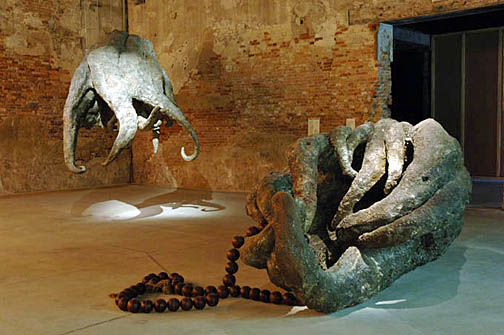
'Buddha's Hand' is the root of a Chinese medicinal plant (citrus medica sarcodactylis) used to promote longevity. Put on the floor, its gigantic form reminds one of the Buddha's hand holding an exaggeratedly oversized rosary. The monumentality of the piece amplifies the metaphor of the power of religion on man in a caricatured manner: Here reigns an apparent peace (or danger) which will be found again in the second 'hand' with its many fingers suspended from the wall into gallery space, like the articulated tentacles of an octopus in full action. This suspended hand has a strong choreographic presence in the space, while its willowy forms associate with our unconscious feelings of fascination and fear beyond any
Buddha's Intestines
2012
First shown at Centre international dart et du paysage de
lîle de Vassivière, France 2006
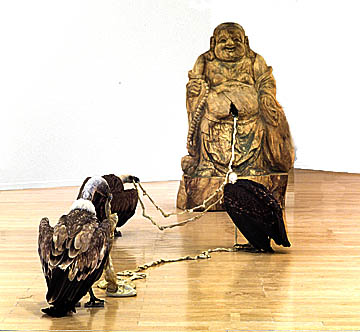
Buddha's intestines, made of silk,
spill over the floor. The room is like a womb where one finds the
viscera of the Pantheon with the wooden sculpture of Buddha, guided
by a horde of vultures that rip out his innards. The appearance of
the vultures not only prepares the retreat of the gods, but at the
same time also predicts their return
e-flux.com
Bugarach, Mayan
Armageddon
December 2012
As the Mayan predictions for the end of the world enliven the imaginations as to the nature a of post-apocalyptic universe, superstcious Huang Yong Ping is a step ahead of most. The Chinese artist’s bitterly inventive mind has created an installation at the Kamel Mennour gallery with a vision of Bugarach, a village in the Pyrenees that some calculations suggest would just escape a global meltdown.
|
|
|
|
Decapitated tigers, horses, snakes,
deer, polar bears and more surround the remainder of the mountainous
peak, a rocky eruption from the floor of the gallery. At the rear of
this unearthly scree, an enormous plate protrudes from the side of
the mountain, a literal flying saucer. Animal heads are stuck to it,
staring at a plastic helicopter suspended from the ceiling, as if
hallucinating some post-apocalyptic angel.
This absurd farce, full
of scorn, is characteristic of Huang Yong Ping’s love of paradox
and sharp critical sense. – A grandchild of Dadaism, the artist
expresses something simultaneously ridiculous, almost burlesque, and
extremely violent. There’s nothing to rescue here, no all-powerful
salvation, nothing but dead skin.
The mythological airs of the
scene reference all the great religious myths and their much more
fierce rites and theories. A surrealist collage of discordant
elements, ‘Bugarach’ points to a violent, self-destructive
destiny for contemporary society.
mybelishhabeacon
'Ressort
2012'
2012
Queensland Art Gallery, Australia
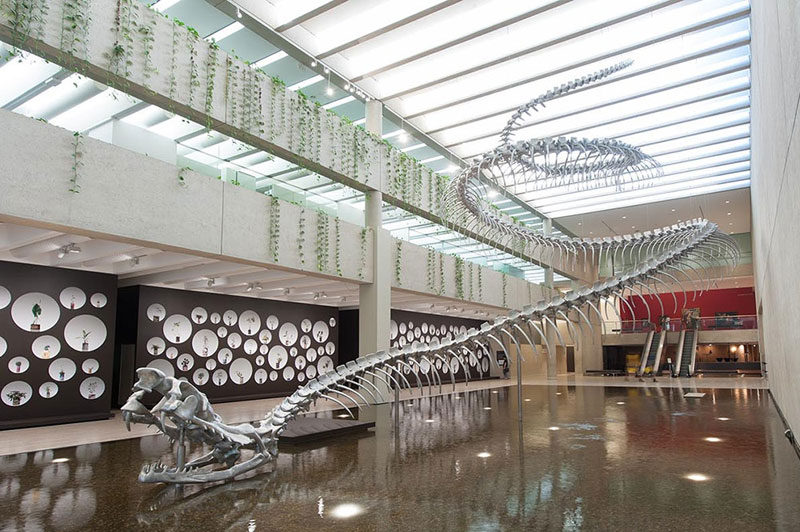
'Ressort
2012', Giant Python/Dragon skeleton, cast alumminium, 175 ft
Huang's massive installations rework
architectural and animal forms into complex tableaux, drawing in
elements of the sites in which they are constructed. Huang’s series
of snake skeleton sculptures reference a central symbol (Dragon) in
Chinese culture, as well as other cultures around the world. Designed
for various locations, from a bridge in Germany (2000) to a beach in
France (2012), these works play with different interpretations of the
snake, as well as referencing local landscapes and architecture.
Ressort 2012 dominates the Queensland Art Gallery’s Watermall,
spiralling from the ceiling to the floor, metaphorically linking sky
and water.
Ressort
has several meanings in French: Spring, resiliency, resistancy,
spirit.